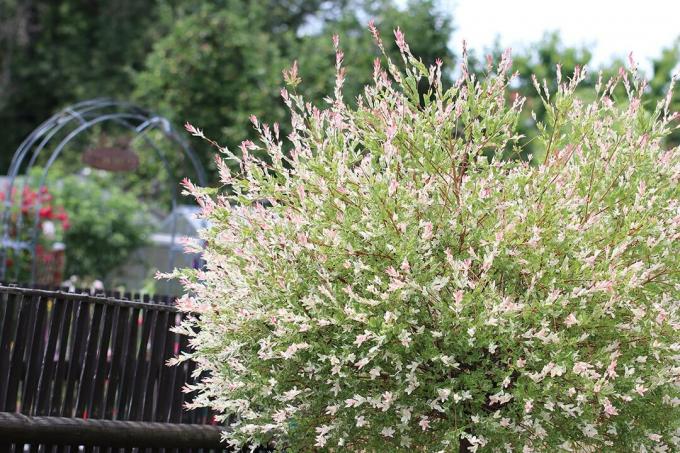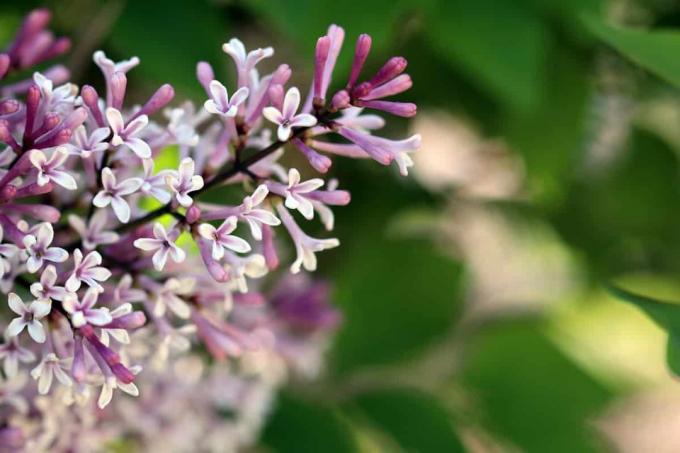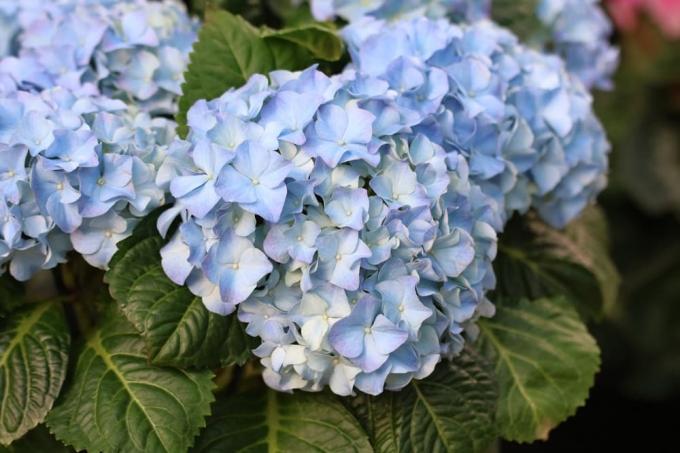

Table of contents
- Characteristics
- site conditions
- soil condition
- planting
- care instructions
- Cut
- standard
- pruning of shrubs
- hibernate
- Propagate harlequin willow
- Diseases & Pests
Characteristic of this ornamental willow is its spherical, broad and squat growth and its strikingly variegated leaves. It doesn't get very big and is an ornament even if there is little space.
Characteristics
- Plant family: Willow family (Salicaceae)
- Origin: Japan
- Growth: compact shrub or stem, spherical crown
- Growth height: 150-300 cm
- Foliage: Shoots pink, variegated green-white, touches pink
- Flowers: single, inconspicuous yellow catkins
- Flowering time: March to April
- Fruit: brown, hairy capsule fruits
- Lime tolerance: Lime tolerant
- Toxicity: non-toxic
site conditions
The coloring of the leaves of the flamingo tree depends primarily on the light intensity. The more light, the more intense the coloring. In the sun, you can show off your look best. However, you should avoid a location in the blazing midday sun, otherwise the leaves could burn. In semi-shade they lose some of their luminosity and tend to stay brighter. In the shade, the coloring is almost completely lost.
soil condition
The soil should ideally be fresh to moist, loose and rich in nutrients and have good water storage capacity. Especially in sunny locations you should make sure that the soil is moist enough. Otherwise, the flamingo pasture normal garden soil is completely sufficient. If you enrich it with mulch or compost, you have done everything right.
planting
The harlequin willow can be planted in spring and autumn. Container plants all year round provided the ground is frost-free. Planting in spring has the advantage that the plant has enough time to take root before the first frost. Avoid planting in summer.
- Dig a sufficiently large planting hole
- Insert willow in the middle
- Fill in with excavated earth
- Water the soil copiously
- Planting distances between 80 and 150 cm
- Use a peg with the trunk
- Preferably towards the weather side
- Stake should give stability to the trunk
- Attach to the stem with a coconut cord

The purpose of the stake is to prevent fine root tissue from being damaged by high winds. Since the roots run relatively flat under the surface, it is important to ensure that the planters are sufficiently large, especially when planting in containers.
Tip:
The unusual coloring of the foliage is best seen in a solitary planting. There are also numerous options for underplanting.
care instructions
Pour
Watering is particularly important in the first few weeks after planting. The soil should be kept as moist as possible and not dry out. So the flamingo tree can quickly gain a foothold. Waterlogging should of course be avoided. Water later as soon as the top layer of soil has dried. Fully grown harlequin willows also tolerate longer periods of drought. Nevertheless, it should be watered occasionally in particularly hot and dry weather, at the latest when the leaves begin to curl up. It is best to only water with rainwater. Specimens in buckets have to be watered more frequently due to their lower volume.
Fertilize
Basically, the flamingo tree does not make any special demands on the soil. If you add some compost to the planting or mulch the tree disc for leaf sprouting in spring, you can usually do without additional fertilizer. At the same time, mulch ensures that the soil does not dry out as quickly. When kept in a tub, a complete fertilizer is given annually when the leaves sprout. From August there is no more fertilization.
Cut
Pruning measures are the be-all and end-all for the flamingo willow. They prevent wild growth, prevent the branches from becoming woody, ensure that the plant retains its shape and the crown grows denser and bushier. It is best to choose an overcast, frost-free day for cutting. Exclusion criteria are blazing sun and drought as well as the closed seasons during the breeding season of numerous bird species.
standard
topiary
High stems of flamingo willow are grafted onto osier, which is known for strong branch growth. Without a cut, it would lose its spherical shape over the years, which ensures an unhindered incidence of light. As a result, a corresponding shape cut is recommended in late winter. Smaller topiary cuts can also be made in the following months if the need arises.
- Cut back crown and remove deadwood
- Cut off old and weak branches at the base
- Cut all remaining branches down to a third
- Shorten a little more
- This results in a stronger shoot
- Never deeper than three eyes
- Do not cut into the grafted trunk
- Last topiary in late summer
Tip:
So-called bypass scissors are recommended for cutting. It enables a precise cut and avoids bruises.
care cut
The maintenance cut serves to achieve a more compact crown shape and to preserve the variegated leaves. The topiary results in vigorous growth, which requires another maintenance cut in summer.
- Best time around St. John's Day at the end of June
- Plants are now entering a growth phase
- This is followed by a second but weaker shoot
- Cut back the crown by a third
- Halfway is no problem either
- Or just shorten branches that protrude from the crown
- Remove shoots that sprout from the stem or root disc

More radical cut
A more radical pruning is recommended if the harlequin willow has not been cut for a long time. Thanks to the high cutting tolerance, this is easily possible.
- The best time is in spring
- Shorten shoots to up to ten centimetres
- Leave at least four eyes per shoot
- Cut out diseased and dead shoots
- Remove laterally growing crown shoots
- Don't leave stubs on the plant
Tip:
A strong pruning should not be done in autumn. The interfaces would heal less well and the plants would be more susceptible to frost damage.
pruning of shrubs
plant cutting
- The aim is a dense branching at the beginning
- Best time right after planting
- Cut back bare-rooted young bushes by half
- Shorten container plants by a third
- Pruning will cause sap to build up in the bottom buds
- This results in increased sprouting at the base of the bush
- More lush branching on the harlequin bush
maintenance cut
After the pruning, the harlequin willow can be allowed to grow for the next two to three years. From the third year it is time for the first maintenance cut.
- Ideally between January and early March
- Be sure to choose a frost-free day
- The goal is a spherical, compact shrub shape
- Thin out dead wood at the base
- As well as inward growing or crossing shoots
Form and care cut
A topiary, which follows the maintenance cut, is also recommended for the shrub shape. Not all, but only the outer branches should be cut back. This creates a nice hemispherical shape. You shorten them by at least a third, so that the budding of this year's young shoots is encouraged.
For opaque growth and a beautiful appearance, the first trimming follows in the summer of the third year of growth, even with the shrub form. The shoots on the outside are shortened more than those in the center.
Rejuvenate / Put on the stick
To revitalize an aging flamingo tree, you can put it on the stick. With this pruning, the shrub is cut back to a few centimeters above the ground. As a result, dormant buds are activated, which in turn ensures new growth. There is no need to cut out individual dead branches and growth is promoted.
Tip:
If the harlequin willow is used as a hedge plant, it is sufficient to shorten it by two thirds every two years.
hibernate

A flamingo willow planted in the bed does not require winter protection. Different in the bucket, here the roots have to be protected. To do this, cover the root area with mulch and wrap the bucket with jute, bubble wrap or similar insulating materials. It is best to place it in a sheltered spot near the house. It is not advisable to spend the winter indoors. In the case of tall stems, the crown is also wrapped in fleece to protect it from the intense winter sun.
Propagate harlequin willow
- Propagation takes place via cuttings
- Take cuttings about 15 cm long
- Allow to root in a glass of water
- Then plant in small pots with a soil-sand mixture
- Keep substrate evenly moist
- Plant in place in spring
- Water regularly until established
Diseases & Pests
fungus
Willow willow is susceptible to fungal diseases such as rust, willow scab and willow anthracnose. An infestation occurs in wet weather in May or June. It shows itself in brown or black, scabby leaves, withered shoot tips and leaf shedding. Affected plants should be cut back heavily, if necessary to a few centimeters above the ground. The clippings are disposed of in the household waste and not in the compost.
willow borer
The caterpillars of the willow borer leave feeding passages up to two centimeters thick. Drill holes can be seen in the bark, drill dust and crumbs of droppings at the base of the trunk. The intense smell of vinegar is also noticeable. Affected plants should be cut back to healthy wood.
willow leaf beetle
The willow leaf beetle also draws attention to itself with food marks and withered, brown or black leaves. This can lead to complete defoliation. In addition to the feeding marks, one can observe orange-coloured oviposition on the leaves. The affected parts of the plant should be removed and discarded. In addition, treatment with a suitable fungicide is recommended.
 Home editorial office
Home editorial office
Learn more about ornamental trees

Shell cypress, Chamaecyparis obtusa: 10 care tips
The clam cypress, which originated in Japan, is one of the most popular evergreen garden plants in this country. The 10 most important tips for caring for conifers have been compiled for you here.

Dwarf lilac: 9 tips for care and pruning
The dwarf lilac impresses with its magnificent and fragrant flowers, which at the same time form an ideal retreat for native insects. The nine most important tips for caring for and especially cutting mini lilacs are summarized here for you.

23 evergreen, hardy & fast growing shrubs
Evergreen and hardy shrubs are ideal for adding color to garden beds, patios and balconies in winter. Fast-growing specimens are particularly in demand. The 23 most popular shrubs can be found in the home garden guide.

The basics of hydrangea care
Hydrangeas provide a real bloom in the garden or on the balcony, as long as they are cared for professionally. Read here how best to do this.

Rhododendron location: 6 important criteria
Rhododendrons are known for their sea of flowers, which, depending on the variety, unfolds its full splendor between March and June. However, the plants only develop the numerous flowers if the location meets their requirements. Rhododendrons are extremely picky when it comes to location.

Identify & recognize shrubs: 8 tips
In order to recognize plants, characteristics such as leaves, flowers, branches and buds are necessary. Hobby gardeners have good basic prerequisites for learning the craft of identifying trees. If you know the peculiarities of the shrubs and bushes, it will be easy for you to start identifying them.
